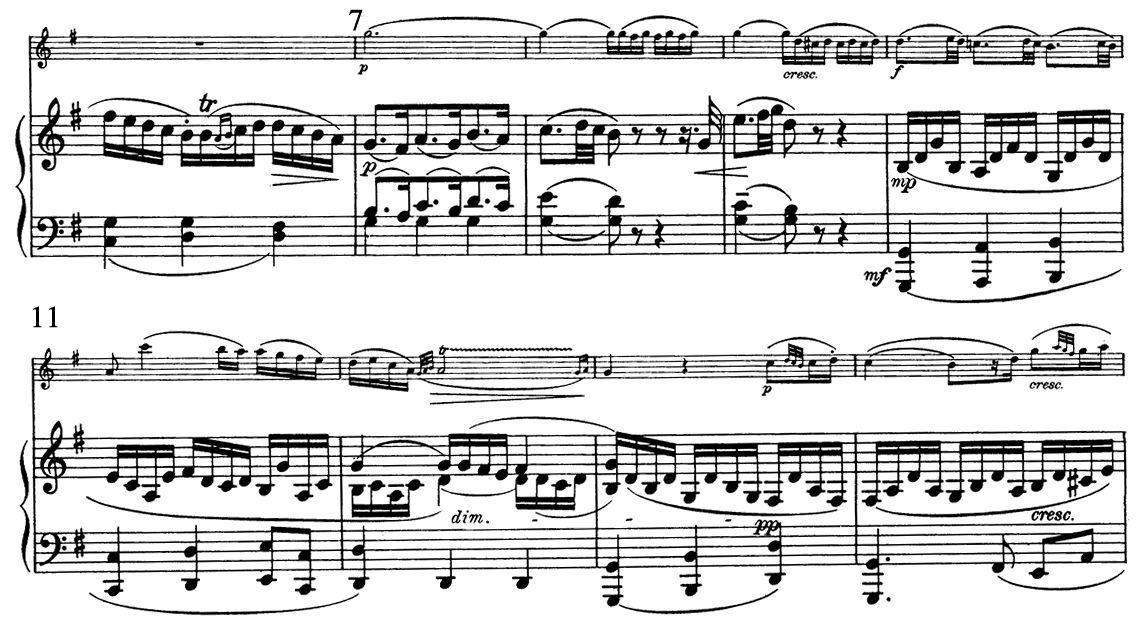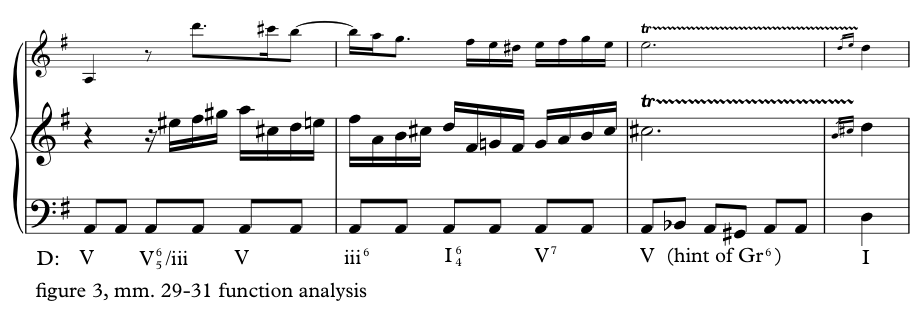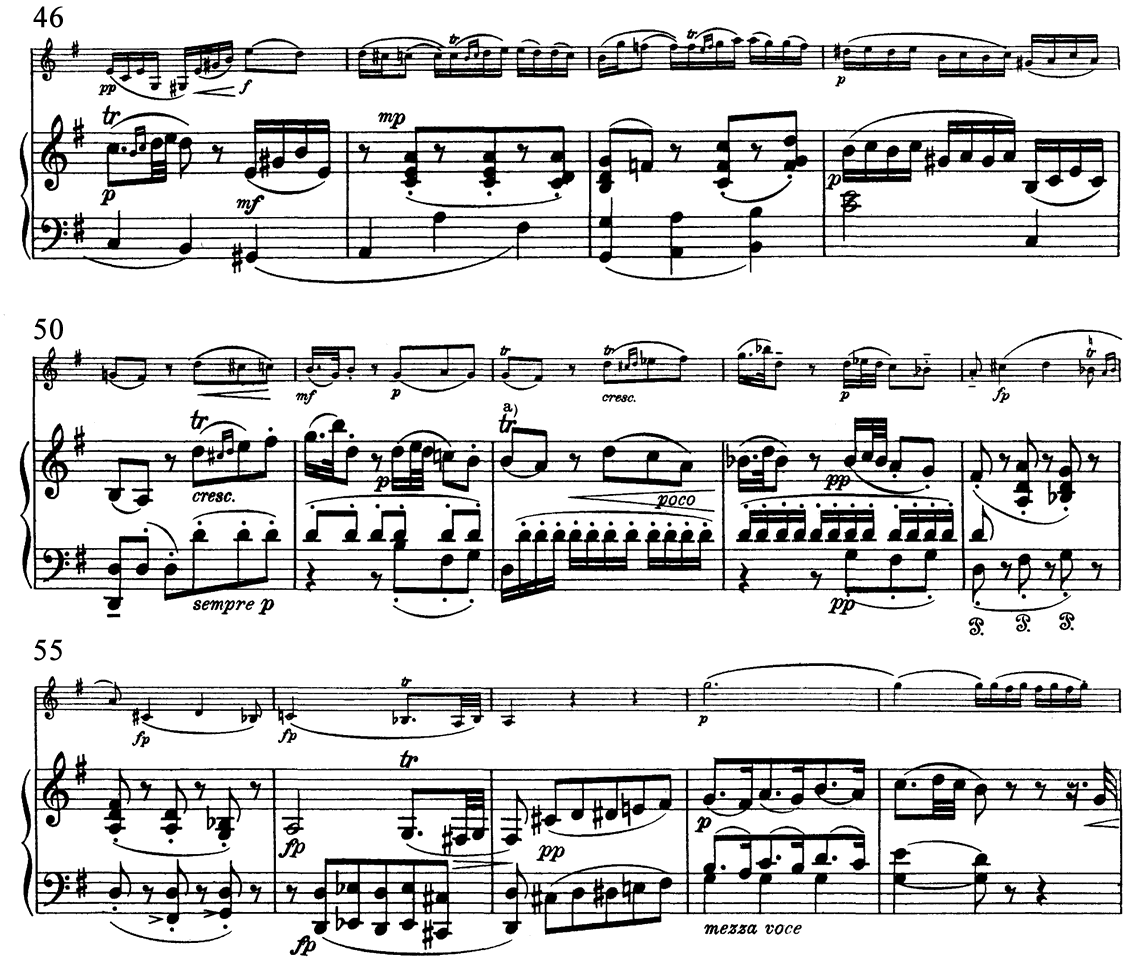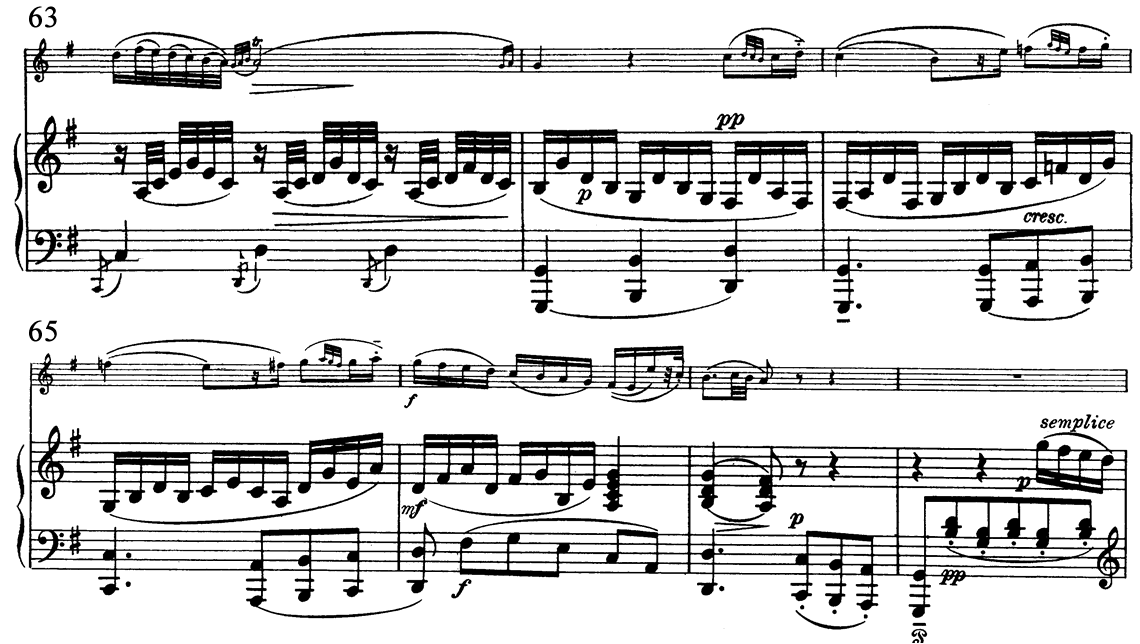Analysis of Mozart’s Sonata for Violin and Piano K. 306 second movement Andantino cantabile
By Sunny Knable
Melody
Mozart famously said, “Melody is the essence of music,” and went on to say, regarding contrapuntalists: “Chi sa più, meno sa.” (Who knows most, knows least.) While he was known for his simple and beautiful lines, this movement is notable for its subtly complex melody and counterpoint. The opening motive in the piano is an ascending dotted figured line (G-A-B-C) which is characterized by its oblique motion to the tonic bass. One can hardly separate the motive from the harmony, for both are so intricately linked in this I-(ii2-I)-IV6/4-I progression, as figure 1 illustrates:

The same voice leading of m. 2 (scale degrees 4-3) can be found in the final cadence of the piano, though the harmonic language has changed. Another strong characteristic of this melody which foreshadows other motives, is the unaccented lower-neighbor tones on the off-beats of the dotted figure. This three-measure sub-phrase is answered in mm. 4-6 with an ascending bass that reappropriates the opening melody into the role of bass line (G-A-B-C), adding to that a contrary-motion line in the soprano voice, essentially exchanging voices, though removed by octave (D-C-B-A), shown in figure 2.

This operation of voice exchange, strong associated with the contrapuntal style of the Baroque, works just as well and quite often in this Classical-form movement. While the melody is obvious in its function, we shall see soon that the harmony of this movement becomes a defining characteristic as well.
The violin melody which enters at m. 7 doubles the bass line. Its 16th-note motion begins only where the piano’s melody stops, dove-tailing its release with a note in the harmony and its lower-chromatic neighbor; this lasts until m. 10, at which point it picks up the role of melody (just as in m. 4), becoming the consequent phrase to the opening antecedent. As the analysis of the phrase structure outlined, the harmony of the second phrase suggests that the third phrase begins at m. 13, whereas the melody in the violin overlaps this, obscuring the line of where the phrases begin and end. This phrase, from m. 7 therefore, can be seen as a seven-measure phrase for the violin, the next phrase beginning with the pick-up to m. 14. Is the audience to listen to the violin or to the piano to determine where phrases begin and end? It seems that the tension between the two is the element that the audience should revel in.

Other interesting motivic characteristics of the Exposition include the Second Subject, beginning with the piano in m. 19. The half-step figuration in the second half of this bar was foreshadowed in the violin part of m. 7 in the exact same register and placement of rhythm, and is developed here as a fully fleshed out theme of its own. The end of this phrase is notable for its chromatic motion in the soprano, diluting the cadence with an Imperfect Authentic Cadence. When the violin plays the same theme, Mozart adds to it rhythmic alterations rarely seen in the piece, with flashier triplet and 32nd-note figuration. The end of this phrase is especially notable for its rising E-harmonic-minor scale in m. 26 (another dilution of the potential cadence), answered in the piano at m. 28 with an ascending hybrid scale, which seems as if to be an A-harmonic-minor scale until the inclusion of the C# (related to F# minor in the next measure). Perhaps to signal the arrival of the Transition, Mozart gives the violin its first bass role on the down-beat of m. 29, only to return it to the soprano one note later. The texture of these three measures is notable for its sparseness: a running 16th-note figure flirting with F#-minor over a pedal-A in the piano; above this is a syncopated violin melody descends into a trill (in 3rd’s with the piano) and the first unison note of the piece, a D on the downbeat of m. 32. This counterpoint is also notable for its suggestive voice-leading as seen in figure 3.

Though a three-part texture, the treble line of the piano, suggests a soprano and alto line. It is also interesting to see where the violin and piano double at the octave or unison in these measures: the off-beat C# of m. 29 (beat 3), the off-beat F# of m. 29 (beat 2) and the downbeat of m. 32 (beat 1), making for a kind of musical “count-down”. The dotted figures of m. 32 in the piano, and the first extended figure in the piece, doubled in octaves, makes a strong closing statement of the Exposition, punctuated with the first PAC this section (though obscured by the pedal-D). This is further fortified with an unusually thick voicing of the full D major chord in the bass notes of the piano, which work against the dynamic instruction to diminuendo to this chord. It is only through great effort that the pianist can manage that voicing properly.
Dotted figures abound at the start of the Development, apropos of the opening figure, but differentiate themselves with a stark double-octave texture in the piano, answered by a florid violin line. The rising melody is also reminiscent of the ascending melody and bass lines of the start, though now exploring the dominant key. In the first event of its kind thus far, the violin and piano lines are reversed in role and range from the pick-up to mm. 45-46, the violin arpeggiating chords underneath the piano’s melody. After switching back to their normal roles of melody and accompaniment, the violin and piano join in 3rd’s at m. 49 with accented non-chord tones, in reference to the lower-neighbor relations of the Exposition. The pick-up to m. 51 is unique in that the violin and piano melodies start on a unison D, and go in leave in contrary motion, such that the dotted rhythms of this Retransition operate in 6th’s and 3rd’s (with piano in the soprano voice), switching again with an opposite figuration in the pick-up to m. 53. The Development is concluded with the violin and piano harmonizing in 3rd’s, landing on the dominant of the home key downbeat of m. 57. Despite its upbeat function, the half-cadence at this measure seems diluted by a pianissimo ascending chromatic figure in the piano, which has a way of slipping into the Recapitulation in a covert fashion.
The Recapitulation is different from the Exposition mainly in its insistence of the tonic key, though some small choices to voicing and figuration help to fortify the crucial places in which they differ. An exact repetition of the opening Exposition material (corresponding to m. 7) is avoided by a rhythmic doubling in the piano arpeggios of mm. 61-63. These 32nd-notes are also added to the melody at m. 63, increasing the feeling of arrival of the tonic at m. 64. In the Second Subject of the Recapitulation, the only difference from the Exposition besides modulation and adjustments in range is in the last chord of m. 72, in which, to left hand of the piano, Mozart adds a 7th in the dominant chord (whose voice leading again supports the opening [scale degrees 4-3]), further fortify the weak cadence at m. 73. Where the violin is transposed up a 4th in m. 79, the answer to this in the piano, is transposed down a 5th in m. 79, the range of which serves to accentuate the dissonance of this strange scale. (Notes lower on the piano, of course, resonate more fully.) The only other alteration to the Codetta material is in the final measure of the movement: where Mozart chose to double the melody with a PAC cadence in the Exposition, he instead chooses a more subdued ending, with an IAC in the piano, but a 7-1 motion in the violin (over the pedal-G of the bass). This final cadence is again fortified with a full and thick tonic chord in the bass of the piano, in tension with the diminuendo marking.
©2018 Sunny Knable. Published by teoria.com

